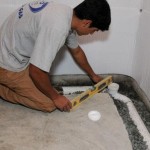What does mold need to grow indoors?
Folks often ask me what mold needs to grow indoors. The answer is pretty simple because it involves only three things. Just like most creatures, mold needs food, moisture and suitable temperatures. Inside a home or office, the moderate temperatures are usually a given, so we are down to two. The three main food groups that mold seems to enjoy are carpet, drywall and fiberglass insulation. Read More…
How can we avoid mold?
Checking for mold in your house is part of smart household maintenance. Mold grows in damp, dark areas and can cause serious damage to your house and health if it grows undetected. Knowing how to check for mold in your house is an important part of saving money, health problems and your home’s structure. Read More…
What should I expect when I get a mold inspection?
The inspection process includes a general understanding of the building, including age, number of stories, roofing and siding type, and presence of basements or crawlspaces. Read More…
Why does mold grow in basements and crawlspaces?
Mold does not need liquid moisture. Liquid moisture is essentially 100% relative humidity, like when water condenses on your air conditioning coil because the air passing over the coil has reached the dew point temperature. The dew point is the temperature where a given mass of air is holding as much moisture as it can hold. The warmer the air, the higher the dew point. In the summer in the northeast US, typical dew point temperatures are in the range of 50-65 oF. So if a warm, summer air mass at say 80 oF encounters a cool 65 oF space, its relative humidity will automatically increase. And guess what: Most basements and crawlspaces maintain temperature around 65 oF, so by definition they are more humid than other interior building spaces. Read More…
Should I spray bleach on mold?
The presence of active mold growth inside an occupied building requires remediation measures to remove the growth. Existing industry standards published by the Environmental Protection Agency (EPA), American Industrial Association (AIHA), Institute of Inspection, Cleaning and Restoration Certification (IICRC), American Conference of Industrial Hygiene (ACGIH) and others all emphasize the need to remove the mold growth. Read More…
Are there permanent solutions to basement moisture problems?
Because of their cool temperatures, the relative humidity in our basements and crawlspaces is normally in the 60-70% range, which is right on the moisture boundary where mold can grow. If we add any additional moisture we almost always push humidity levels above 70% and presto chango, we start growing mold. Read More…
How are you able to find mold problems when I don’t see anything?
Clients frequently ask us, “How are you able to find mold problems when I don’t see anything and neither does anybody else.” Or a common variation on this theme, “I have a mold test but I don’t know what it means.” Our answer is, we follow the Sherlock Holmes investigative approach that has been described in virtually all of the published standards. Read More…
What are the mold remediation procedures?
We reference the industry standard Bioaerosols: Assessment and Control (1999), published by the American Conference of Governmental Industrial Hygienists (ACGIH). The ACGIH standard is the current authority on biological contamination, and is a practical guide for identifying and correcting suspected sources of microbiological amplification. Read More…
